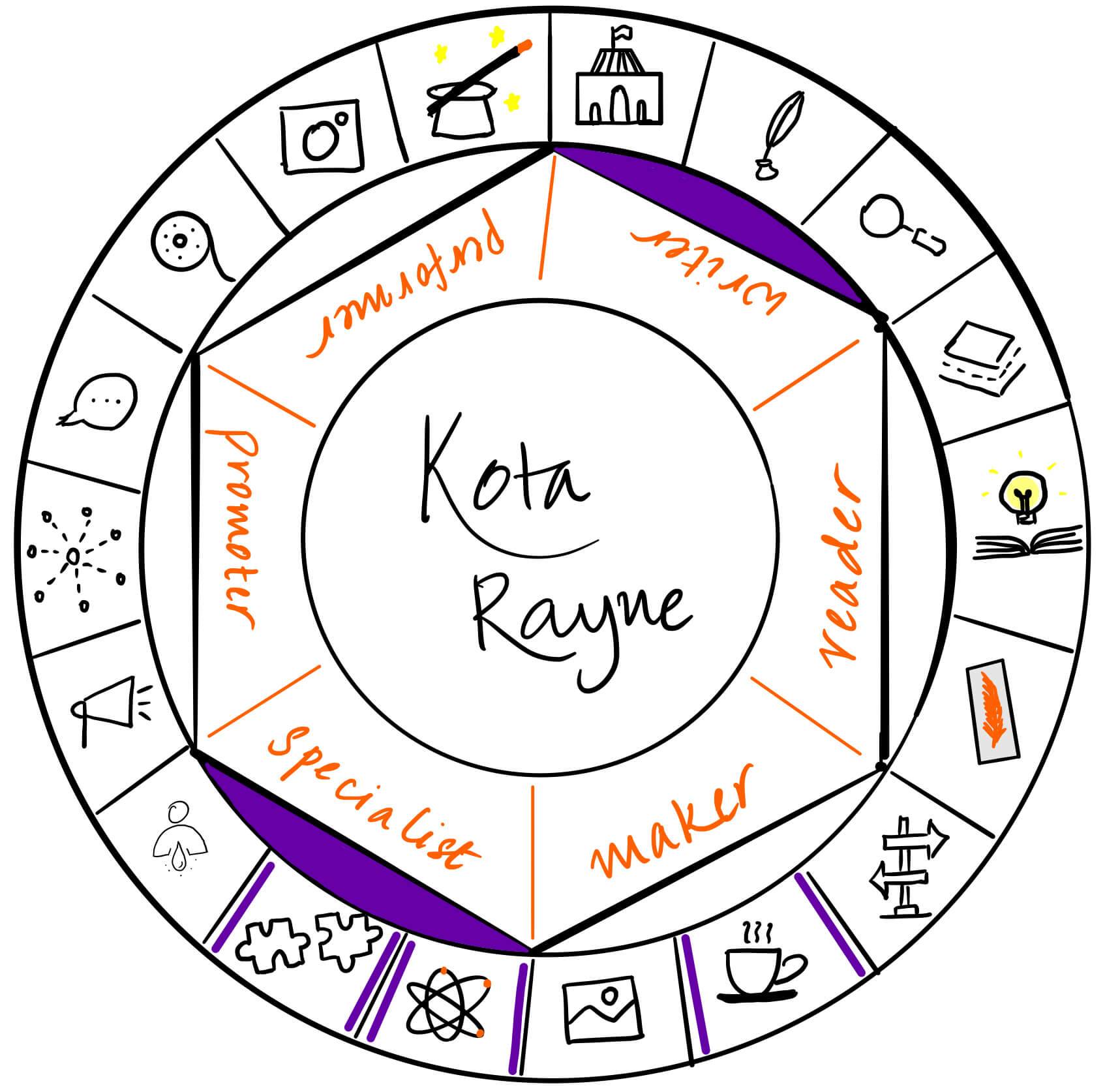Hello friends. Thank you so much for joining me for another amazing Creator’s Roulette today. After chatting with Pam about booktube just the other week and looking at the reviewer/avid reader side of things, I thought it would be nice to turn to the insides of publishing for a quick change. Today I have Kota Rayne from Inked in Gray Press and we are celebrating the launch of the press’s second annual anthology by talking about anthologies!

Publishing An Anthology: Q&A with Kota
Kota, welcome to The Creator’s Roulette! Tell us about Inked in Gray and how it came to be.
Inked . . . Inked is the product of my extreme frustration with the world as it is. I grew up being told to shut up, sit down, and get out of the way. Especially when the things going on around me were just plain wrong. I was emotionally beat down into this place, deep inside, because that was the only place I could be safe – being silent and out of the way. But then I turned 18 and made a shit ton of bad decisions trying desperately to figure out who I was while trying to stay afloat on the street. I lived and worked on those streets, side by side with folks from all walks of life, but mostly gang-affiliated, transient, trafficked, and undocumented.
The most common response to our struggles was “you’re not trying hard enough.” “You’re lying” “You could be successful if you wanted to.” “You should be more f*cked up than this” But anyway, I digress. But you asked how Inked came to be, and if I didn’t sleep in sketchy places for a bunch of years, Inked would not be in existence.
What we see in the media is a drastically incomplete picture of the world around us. It furthers stereotypes, promotes prejudice, and builds barriers between communities – an intentional division to keep us from banding together to change things.
Well, fuck that.
But words have the power to elicit change. Words build communities, dissolve stereotypes, and promote empathy and understanding. That’s the magic of storytelling. With Inked, I want to give a voice to the misrepresented and provide stories that don’t just entertain, but also promote change and understanding. Voices should not be unheard because they are not what we expect.
Thus Inked was born, over a cup of coffee and promise. We hope to grow Inked into a platform for stories to explore those aspects of our humanity and give a voice to divergent and underrepresented authors. No sugar-coating, no watering down, no pulling punches.If you’re interested in a personal look at how Inked in Gray came to be, a longer version can be found here.
Did you always want to be a publisher or were you more focused on being a writer originally?
Honestly, I was always focused on helping people. It’s just something that’s in my blood. If I can do something, I will. It rarely occurs to me to say ‘no’ when something is needed and I can provide it. I’ve always been a storyteller and an advocate, always frustrated with the gatekeeping and oppression that surrounds voices, especially voices of marginalized individuals. It’s always been a desire of mine to help bridge that gap of understanding, and to facilitate the telling of those stories. So for me, being both a writer and a publisher were always meant the same goal.

The First Stain was a wonderful debut into the dark short stories realm, with stories focusing on the gray – death, redemption, beautiful lies. What remains, as your second anthology, also touches on themes of grief and desperation. What draws you to these themes?
The current times. With not just covid, but the general happenings in the world around us have escalated – wars, genocide, corruption. It seems like the world has gone to shit, but really it’s just that we are not unable to withdraw ourselves from the cruelty of this world because it is so blatantly in our faces. In a long enough timeline, our survival rate goes down to zero, the longer we remain, the greater our exposure to the grief, desperation, and helplessness we feel to do anything to stop the evils of this world. And that is essentially the scope of What Remains: to take those feelings and give them an outlet. Each story has a way of turning that hopelessness, grief, and desperation on its head, and taking back that control, because that is what we wish to do, yes? If we could, if we had the power, we would fix all the wrongs in the world.
Why did you choose an anthology as your debut?
We chose to do an anthology as a debut because it was a way to showcase works from the writing community and start to build an audience by giving them a little taste of who Inked is, and what we are about. And we will keep doing anthologies, they are so much fun. I get to meet and collaborate with so many authors and their amazing stories.
Can you tell us about the process of publishing an anthology? Where do you start as a publisher?
Creating a timeline!! With lists!! An anthology is a broad project, in the sense that there is a lot involved. From finding the theme and accurately expressing the parameters to reading and editing all the submissions. Map everything out, give yourself more time than you think you need, and making sure you have enough help. This past year, we received about 380 entries for What Remains. Had I not been prepared, I think the process would have taken much, much longer. I had colleagues prepped and ready should I need their help, and without them, we’d be still reading submissions.
If you’re looking to do your own anthology or collaboration, give time for finding the right cover, the back and forth edits, and for ARC readers to read and review. And don’t forget your authors. I personally like to involve the authors in the process of not just the edits, but the outreach and marketing. Nothing I do at Inked is a one way, top-down initiative. I don’t know everything (no one does) and having authors collaborate and offer their ideas has honestly made both anthologies much more successful and satisfying.

What’s the most challenging part of the process?
Picking the top stories. 100%, hands down the hardest, most difficult part of the process. I hate handing out rejections. For many of the stories, they were so so good, just either not a good fit for this particular anthology, or I had to agonizingly pick between two or more stories with the same topic. We had so many great stories. So many.
What’s the more rewarding part?
Working with the authors, helping them take that story to the next level. I love the connections I’ve made, and the friends I’ve made working authors. Hearing the feedback from authors that I really ‘got’ their story, and that they had a lot of fun working together, because that is what the experience with a publisher should be – fun and empowering.
Do anthologies differ from standalone or series books in terms of publishing, marketing in particular?
It’s always much harder to advertise an anthology as opposed to a standalone or series. A series, obviously there the previous books to utilize, and a standalone allows you much more time with the characters. An anthology is a series of small moments, so the stories contained within must give variety, but also meld together. Marketing an anthology relies heavily on appealing to theme and purpose. Many may like a few of the stories and/or authors, and not the rest. It happens, which is why overall tone and content are important when putting a collection together.
What kind of response have you received from your advanced reviewers of What remains and readers of The First Stain?
The response has been positive. We have some really powerful stories that take the interpretation of survival past the physical representation of survival and into the psychological and metaphysical. I’ve had a few people tell me that some of the stories have made them cry because they are so relatable, and that is a good feeling.
What lessons did you learn from the first anthology that helped you for this one?
Always leave extra time for things, and be flexible with deadlines. There are things that come up, and when running both a small press and a nonprofit, there’s always something to be done.. Covid this year messed a lot of things up, and still continues to do so. In the greater supply chain of publishing, things are taking longer because we as people have a shortened bandwidth for production – whether that be physically or mentally – so being patient is just a necessity.

Do you have an idea for next year’s anthology already?
I laugh because we’ve already started talking about that. It seems as though the year has gone by so fast and already we’re close to having to announce the next one. Where did the time go? We have not decided on the theme as of yet, but we are actively taking suggestions. If you have a suggestion, please let us know! We would love to hear it. Here’s the google form you can fill out, but you can also email us.
What advice would you give to authors entering a test similar to yours to have their story be part of an anthology?
Oh dear. Firstly, read the directions. Read the theme or any information the publisher has about the open call. If something is not clear, ask questions. We are human, we miss things. Don’t on a whim submit your story without following the directions or submit a story that doesn’t have anything to do with the theme. If it feels like a stretch, then to the publisher, it’s going to feel like a stretch as well. We did end up rejecting some stories because the author did not follow the directions, such as including the blurb or a bio. If you realize that you’ve forgotten something, send us a line with the correction. We don’t expect the person submitting to be perfect either.
What are some of your favorite anthology books?
How many am I allowed? You know what, I’m just gonna list them off, and you tell me when to stop
- The Heart2Heart Anthologies
- From Ashes to Magic
- Both Sides: Stories from the Border
- Lullabies for Suffering: Tales of Addiction Horror
- Heroes Wanted
- Latinx Rising
- Art of War
- Lost and Found
Why is storytelling important to you?
Do you have any recommendations for anthologies for us to check out? Let us know in the comments.
Thank you once again everyone for joining us! I hope you enjoyed this conversation and saw a glimpse of the publishing side of things for a chance. Connect with Kota on Twitter, Instagram and Facebook. Learn more about Inked in Gray press on Twitter, Instagram and Facebook. If you are curious about The First Stain, check out my review of the book here.

Banner Photo by Patrick Fore on Unsplash

Be First to Comment